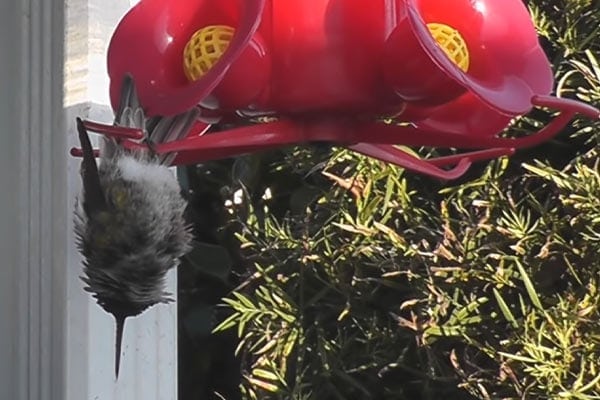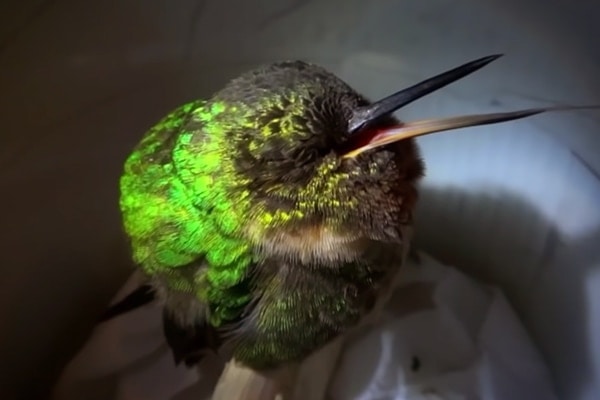I love watching hummingbirds in my yard but I’ve always wondered, “where do hummingbirds sleep at night?” So… I decided to do my homework and get the most complete answer which I am sharing here!
When hummingbirds sleep, they go into a hibernation-like state called torpor. Essentially, this is a state of deep sleep where everything in their body slows down to conserve much-needed energy. By settling into a state of torpor, hummingbirds can save up to 60% of their available energy.
If you’ve been wondering where hummingbirds sleep, you might have some luck with live hummingbird cams that allow you to see and monitor hummingbirds in their natural habitat.
Where They Sleep
Where do hummingbirds sleep? Hummingbirds are extremely small and weigh less than a nickel so finding a safe place to enter into their hibernation-like deep sleep is a priority.
Safe Places to Perch
Hummingbirds need a place far from wind, rain, and icy cold temperatures. When hummingbirds sense that the night is approaching, they will start to prepare themselves for torpor. Inevitably, hummingbirds will settle in a favorite sheltered perching place where they feel safe, both for sleeping and waking up.
Awakening can be a dangerous time for a hummingbird because they are left with only enough energy in their tiny bodies to make it to the next morning. This makes finding a safe perching place particularly critical.
In Their Nests
If a hummingbird is leaving behind baby hummingbirds in a nest where they cannot care for themselves, the mother of the baby hummingbirds, usually born two at a time, will sleep on the nest itself. She will poof out her feathers to create as much insulation and warmth as possible.
Hummingbirds generally build their nests in sheltered trees with covered branches. They also use large shrubbery,
On Twigs or Branches
Hummingbirds look for twigs or branches where they can be sheltered from the wind, cold, and rain. These are usually deeper into the trees and shrubbery in order to sleep safely. Recessed caves can also serve as sheltered spaces. Roosting often occurs in thermally buffered caves as they are welcomed warm spots.
Hummingbirds latch onto a branch with their tiny feet or hook their tiny legs onto tree twigs, but that’s all they can do. This affects how they sleep. Unlike most birds, hummingbirds can’t hop or walk on their legs. They use their legs only for perching and moving sideways.
Hanging Upside Down

You may also see hummingbirds hanging upside-down when they’re perched on a branch or a feeder. If you happen to see a hummingbird hanging upside-down and they appear not to be breathing, it’s more likely that they are just asleep. Even if you touch them, they may not respond. It’s best to leave them alone and let them finish sleeping.
Under a Porch Light
If a hummingbird is confused by bright glaring porch lights or other unnatural light sources, they may choose to forgo sleeping altogether. In those instances, they may decide to keep on feeding late into the night.
Note that this will only happen during warm weather since hummingbirds use torpor to keep warm and not solely to conserve energy.
How They Sleep
With eyes closed, hummingbirds sleep with their feathers fluffed out, maximizing the insulation their small feathers can provide. They often resemble a tiny cotton ball. Unless they’re upside down, their beak will be pointing sharply upward. Their heartbeat will slow down to the point where the tiny birds may appear not to be breathing. They are alive!

Why They Sleep
Sleep is undoubtedly important for all animals, but birds tend to sleep differently than other animals. Here are a few reasons why sleep is essential for hummingbirds.
To Maintain Body Heat
Hummingbirds are warm-blooded creatures. Surprisingly, they need to maintain a constant body temperature even higher than humans. For a human body, the ideal temperature is 98.6 degrees, as compared to hummingbirds that must maintain a temperature between 104 and 108 degrees.
Keep in mind that hummingbirds need to rely on their metabolism to maintain their body heat. In order to do this at night, they become inactive. It is during the rest period that their body temp drops from 104 degrees, which is enough to stay alive but little else.
To Replenish Energy
Everything about the hummingbird uses energy. They must sleep to recover. During the day, they have to feed every 15-20 minutes, and they can’t sustain that level of activity through the night. Using torpor as their method of sleep allows these tiny birds to use as little energy as possible so they awaken refreshed and alert.
Even during torpor, with their metabolism slowed down, the energy used by the hummingbird is nearly equal to that of a human exercising vigorously!
Hummingbirds are busy little birds and use up a lot of energy by:
- Having their wings in constant motion, which creates the humming noise they are named after
- Hovering while they eat, which is most of the day
- By increasing fat deposits as dusk approaches prior to entering torpor
- Performing amazing feats of flying every day
- Speeding up to 60 miles per hour in the span of three feet
To Survive Cold Nights
Torpor is a way for hummingbirds to survive on colder nights. As the sun goes down, the nights can get cold, even in moderate climates. By reducing their own temperature to the ambient temperatures around them, hummingbirds have developed a way to survive freezing cold nights.
When it’s time for them to wake up, the process can be slow. It can take 20 minutes to an hour for a hummingbird to sufficiently warm itself. Interestingly enough, as they take in more oxygen, they begin to make little noise, which some would argue sounds like human snoring.
Their oxygen intake is followed by intentional shivering, which sends blood flow throughout their tiny bodies. When they awaken, they will immediately search for food. Hummingbirds will eat 25% of their daily intake as soon as they recover from torpor. Keep your feeders out!
Why Their Flying Style Requires Sleep
Hummingbirds beat their wings continuously without ever stopping. The movement is so fast and constant, it makes a humming sound. With this type of agility and speed, they expend huge amounts of energy and must use torpor to conserve energy. Not surprisingly, the hummingbird has the highest energy output per unit of body weight of any animal in the world.
All hummingbirds fly with great precision, with the ability to gain immense speed through the air and to stop just as suddenly. They can seemingly hang motionless in midair, and they can adjust their position sideways, up, down, and even backwards.
According to a Stanford University study comparing hummingbirds to helicopters, a hovering hummingbird consumes about 726 Btu of energy per pound per hour. This is very close to the 750 Btu consumed by a helicopter in flight.
Migration – No Time To Sleep
Hummingbirds are the smallest migrating bird. Surprisingly, they do not migrate in flocks. These solitary birds travel hundreds of miles at a time, with no stopping and no sleeping. They can fly up to 60 miles per hour, skimming the darkened landscape unafraid and without a flock.
Bird conservationists have become more aware of the importance of video cameras. In addition to monitoring migratory routes, some birds’ live cam also record bird behavior at the time of occurrence, prior to the start of their migration.
Final Thoughts
It is still unknown exactly how a species can place their bodies into these torpor states for extended periods of time. Humans do not have that ability, but what if they did? Imagine being on a freezing cold mountain, losing energy and running out of food. Imagine not needing food and not feeling cold because your body was itself cold. Amazing.
The post Complete Answer To Where Do Hummingbirds Sleep at Night? appeared first on BirdInformer.com.
from BirdInformer.com https://ift.tt/2Y7ffvB

No comments:
Post a Comment